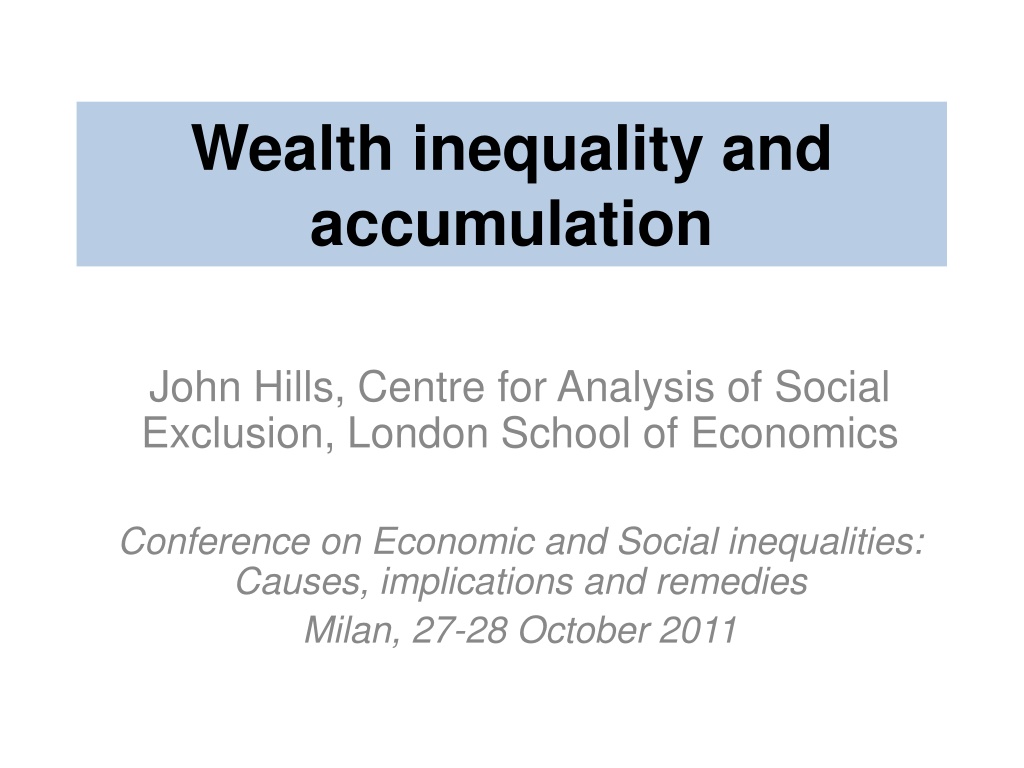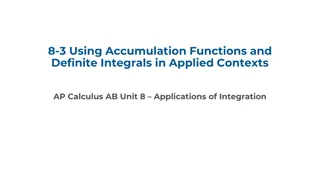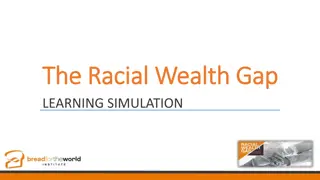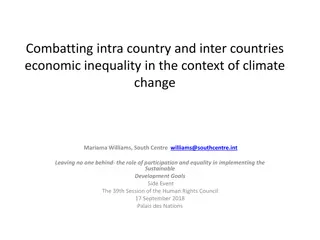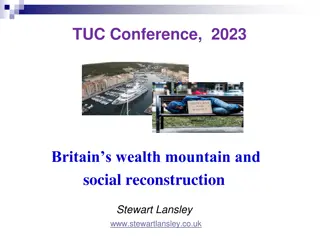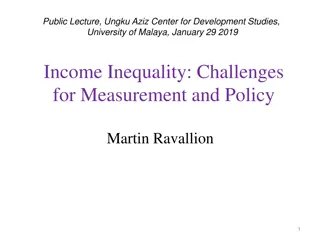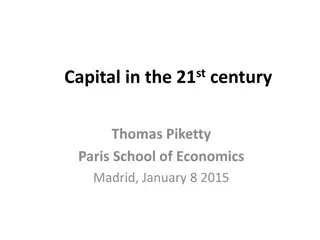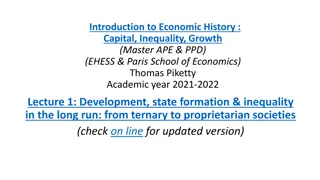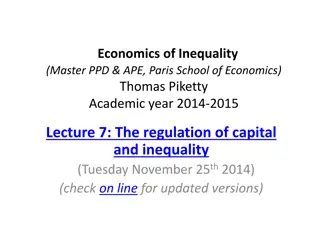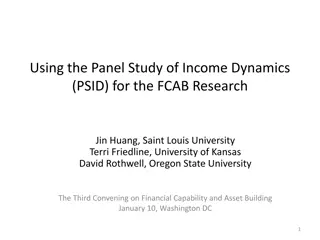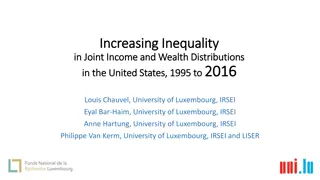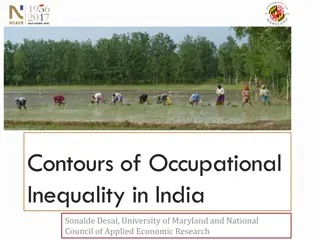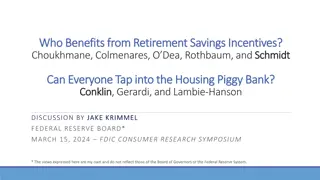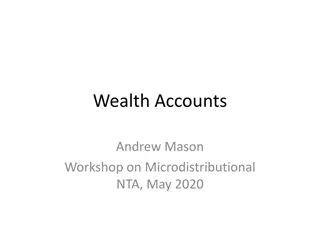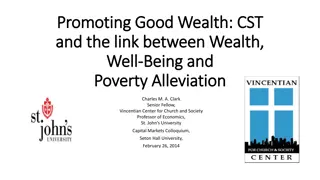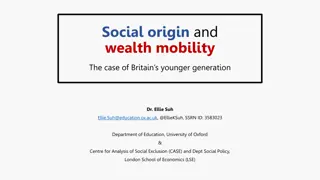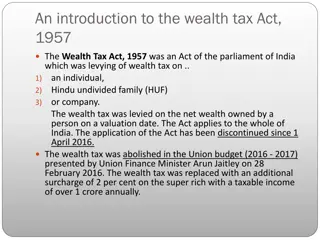Wealth Inequality and Accumulation Paradoxes in the UK
UK's wealth distribution and accumulation exhibit paradoxes despite high income inequality, with inheritance patterns and wealth measures not aligning with international trends. Personal wealth importance has increased, and individual wealth distribution has remained relatively stable over decades, showing both consistent and changing patterns.
Download Presentation

Please find below an Image/Link to download the presentation.
The content on the website is provided AS IS for your information and personal use only. It may not be sold, licensed, or shared on other websites without obtaining consent from the author. Download presentation by click this link. If you encounter any issues during the download, it is possible that the publisher has removed the file from their server.
E N D
Presentation Transcript
Wealth inequality and accumulation John Hills, Centre for Analysis of Social Exclusion, London School of Economics Conference on Economic and Social inequalities: Causes, implications and remedies Milan, 27-28 October 2011
Some paradoxes in UK wealth distribution? The UK has high income inequality in international terms Wider income inequalities since the 1908s have allowed the well-off to accumulate increasing amounts of wealth Inheritances are more likely and are larger for the already advantaged And yet: In international terms UK wealth inequality is not exceptional Conventional wealth inequality measures have been constant or have narrowed in recent years Inheritance does not appear to have widened wealth inequalities
The UK does not look unusual internationally (shares of household net worth, %) Gini Top 1% Top 5% Top 10% coefficient 61 66 68 75 80 81 89 Italy (2002) UK (2000) Finland (1998) Canada (1999) Germany (2002) USA (2001) Sweden (2002) 11 10 13 15 16 25 18 29 30 31 37 38 49 41 42 45 45 53 55 64 58 Source: OECD (2008), table 10.3, based on household survey data from Luxembourg Wealth Survey. US data from PSID.
Personal wealth has become more important (% of GDP, UK, 1950-2005) 700 600 500 400 300 200 100 0 1950 1955 1960 1965 1970 1975 1980 1985 1990 1995 2000 2005 Marketable (IR) Marketable (BO) With private pens (IR) With private pens (BO) With pensions (IR) With pensions (BO)
The individual wealth distribution appears relatively stable over last 30 years (shares of marketable wealth, adults) Gini Top 1% Top 10% Top 50% coefficient 1923 1938 1950 1976 1985 1995 2005 61 55 47 21 18 19 21 89 85 50 49 50 54 92 91 92 94 66 65 65 70 1923 figures are England and Wales only; 1938 and 1950 are Great Britain (from Atkinson, Gordon and Harrison, 1986). 1976-2005 figures are for UK from HMRC. Figures are from estate duty for distribution between individual adults.
But household survey data shows lower inequality since 1995 (Shares of household wealth, %) Gini Top 1% Top 10% Top 50% Financial and housing wealth (BHPS) 1995 2005 Wealth in 2006-2008 on different definitions (WAS) Physical and financial Non-pension 11 Total (with private pensions) 12 8 48 39 96 90 69 59 12 46 89 Na 41 44 90 91 59 61 12 Sources: Own calculations from British Household Panel Study (BHPS; Office for National Statistics, Wealth and Assets Survey (WAS). Figures refer to GB.
But the absolute gaps have widened greatly (household wealth at different points in distribution, 000s, 2005 prices) Mean P10 Median P90 Financial and housing wealth (BHPS): levels ( 000s) 1995 -0.1 2005 0 Financial and housing wealth (BHPS): changes 000s +0.1 37 110 190 390 76 160 +73 +200 +84 Change as multiple of median earnings 0 +3.1 +8.6 +3.6 Source: Own calculations from British Household Panel Study (BHPS). Figures refer to GB.
As a result, while half of households have total wealth (excluding pension rights) over 145,000, a tenth have over 491,000 and one per cent over 1.5 million 2,500,000 2,000,000 1,500,000 1% of the population has wealth of 1.5 million or more 2.2% of the population has zero or negative wealth 1,000,000 1% of the population has negative wealth of 9,570+ P90 = 491,000 P70 = 251,350 500,000 P50 = 145,420 P30 = 45,450 P10 = 7,390 0 5 10 15 20 25 30 35 40 45 50 55 60 65 70 75 80 85 90 95 Percentile Source: ONS, based on Wealth and Assets Survey, 2006/08.
And while half of households have total wealth (including non-state pension rights) over 200,000, a tenth have over 850,000 and one per cent over 2.6 million 2,500,000 1% of the population has wealth of 2.6 million or more 2,000,000 1,500,000 P90= 853,100 1,000,000 P70= 389,000 500,000 Median= 204,500 P30= 73,450 P10= 8,820 0 0 5 10 15 20 25 30 35 40 45 Percentile 50 55 60 65 70 75 80 85 90 95 Source: ONS, based on Wealth and Assets Survey, 2006/08.
The life cycle has a substantial effect, but there is substantial inequality within every age group (P10, P30, median, P70 and P90 for households by age) 85+ 75-84 65-74 Total Wealth 55-64 45-54 35-44 25-34 16-24 0 200,000 400,000 600,000 800,000 1,000,000 1,200,000 1,400,000 Source: ONS Wealth and Assets Survey, 2006/08. Wealth includes private pension rights.
But accumulations between 1995 and 2005 do not follow a life-cycle pattern (Median net wealth, 000, by initial age of household head) 200000 180000 160000 140000 120000 1995 2005 100000 80000 60000 40000 20000 0 <25 25-34 35-44 45-54 55-64 65-74 75+ Source: Own analysis of BHPS. Sub-sample of households with data in both years.
Although they would have done without the house price boom ... (Median net wealth, 000, by initial age of household head; house values adjusted to 1995 house prices ) 200000 180000 160000 140000 120000 1995 2005 100000 80000 60000 40000 20000 0 <25 25-34 35-44 45-54 55-64 65-74 75+ Source: Own analysis of BHPS. Sub-sample of households with data in both years.
And removing the house price boom removes nearly all of the change in distribution Gini P10 Median P90 Mean coefficient Net household worth at 2005 prices ( 000s) 1995 -0.1 2005 0 Net household worth at adjusted house prices ( 000s) 47 146 217 427 86 194 65 53 2005* (adjusted) -0.6 61 223 93 64 Change at 2005 prices ( 000s) Actual house prices Adjusted house prices +0.1 +99 +210 +109 -0.5 +14 +6 +7 Source: Own analysis of BHPS. Sub-sample of households with data in both years.
Does that mean that the paper gains from higher asset prices do not matter? The absolute gaps mean very considerable differentials in the resources available to parents and grandparents to assist their families Inheritances are growing in scale and are also heavily skewed towards the already advantaged Wealth differentials in later life are the best predictor of mortality rates
Labour market inequalities are amplified into huge differences in household resources available for retirement; households aged 55-64 (2006/08) Total Household Wealth ( 000s) P10 Median P90 Large employers and higher managerial Higher professional Lower managerial and professional Intermediate occupations Lower supervisory and technical Semi-routine occupations Routine occupations 370 290 190 84 20 13 8 990 910 670 400 300 220 150 2430 2170 1720 1070 820 640 520 All 28 420 1340 Source: National Equality Panel (2010) fromONS, based on Wealth and Assets Survey, Wealth includes financial assets, houses, and private pension rights.
Inheritance over previous nine years by final net wealth Quintile group of final net wealth (2005) Top Fourth Third Second Bottom Mean wealth ( 000s) Share of net wealth (%) % Mean amount for inheritors ( 000s) 75 29 15 12 7 Share of inherit- ance (%) inheriting (1996 to 2004) 460 197 117 48 -3 56 24 14 6 -0.4 39 28 23 17 11 65 18 7 5 2 Source: Karagiannaki (2011b), tables 8 and 11, based on British Household Panel Survey. All figures at 2005 prices.
Inheritance over following nine years by initial net wealth Quintile group of initial net wealth (1995) Top Fourth Third Second Bottom Mean wealth ( 000s) Share of net wealth (%) % Mean amount for inheritors ( 000s) 59 45 31 36 27 Share of inherit- ance (%) inheriting (1996 to 2004) 265 86 43 11 -3 66 22 11 3 -0.6 37 30 28 25 18 32 24 15 15 8 Source: Karagiannaki (2011b), tables 8 and 11, based on British Household Panel Survey. All figures at 2005 prices. Includes only those households with heads aged 25 or older in 1995.
And wealth differentials are the most powerful predictor of differences in life expectancy in later life in the UK Survival rates after 6 years by wealth group, people aged over 50 (%) Men 92 Women 95 Highest fifth of wealth Lowest fifth of wealth 76 81 Source: English Longitudinal Survey of Ageing
Conclusions Wealth inequality in relative terms in the UK may not be unusual internationally, but personal wealth is more important than in countries where the state plays a larger role. It may be the absolute inequalities in wealth and changes in them (eg in relation to average incomes) that matter, rather than the relative differences and inequality measures These have grown considerably in the UK, particularly as house prices rose. While some of these are paper gains , they still give command over resources to support children and grandchildren during life times and through inheritance. Inheritance may not widen wealth inequality, given its starting point, but it is important in maintaining it. They are also strongly associated with striking differences in life expectancies for those aged over 50.
Papers available at: http://sticerd.lse.ac.uk/case/_new/publications/series.asp?prog=CASE Eleni Karagianakki, Recent trends in the size and the distribution of inherited wealth in the UK, CASE paper 146. Howard Glennerster, A wealth tax abandoned: The Role of the UK Treasury 1974-6, CASE paper 147. Eleni Karagiannaki, The impact of inheritance on the distribution of wealth: Evidence from the UK, CASE paper 148. Abigail McKnight, Estimates of the asset-effect: The search for a causal effect of assets on adult health and employment outcomes, CASE paper 149. Frank Cowell, Inequality among the wealthy, CASE paper 150. Eleni Karagiannaki, The magnitude and correlates of inter vivos transfers in the UK, CASE paper 151. The research described here was carried out at the LSE s Centre for Analysis of Social Exclusion and was supported by the Nuffield Foundation.
